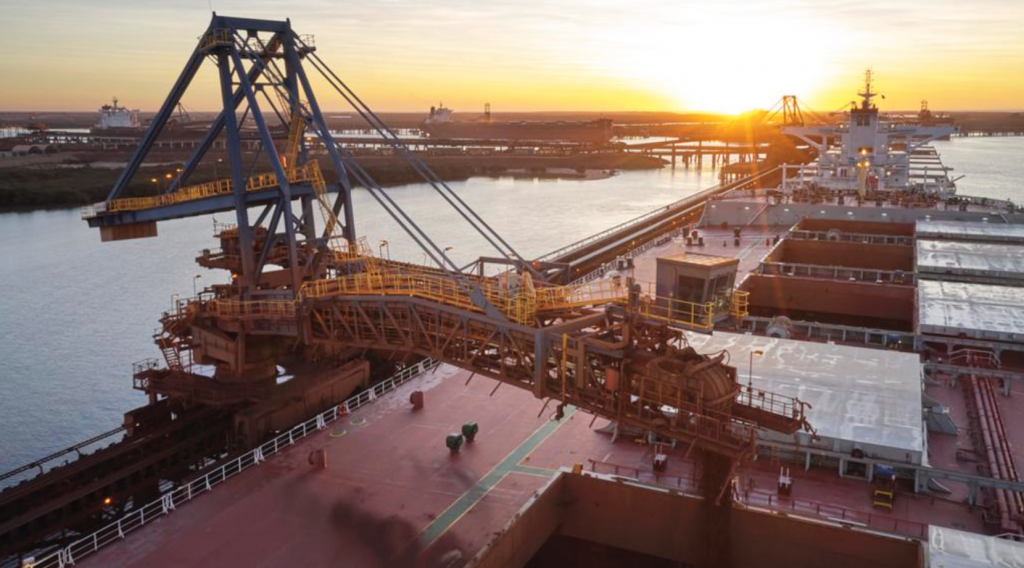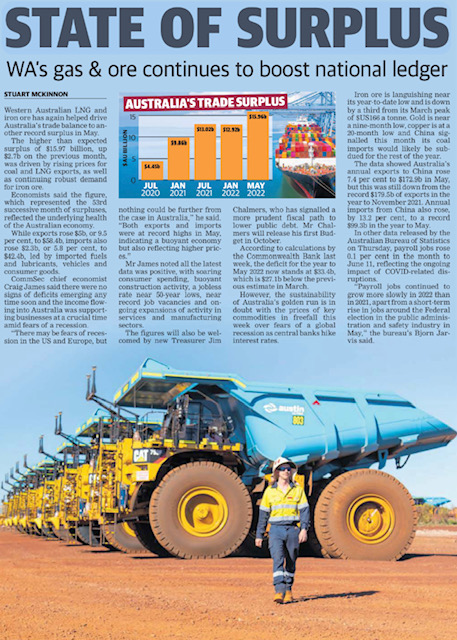
Article by Stuart McKinnon courtesy of the West Australian.

WA’s gas & ore continues to boost national ledger.
Western Australian LNG and iron ore has again helped drive Australia’s trade balance to another record surplus in May.
The higher than expected surplus of $15.97 billion, up $2.7b on the previous month, was driven by rising prices for coal and LNG exports, as well as continuing robust demand for iron ore.
Economists said the figure, which represented the 53rd successive month of surpluses, reflected the underlying health of the Australian economy.
While exports rose $5b, or 9.5 per cent, to $58.4b, imports also rose $2.3b, or 5.8 per cent, to $42.4b, led by imported fuels and lubricants, vehicles and consumer goods.
CommSec chief economist Craig James said there were no signs of deficits emerging any time soon and the income flowing into Australia was supporting businesses at a crucial time amid fears of a recession.
“There may be fears of recession in the US and Europe, but nothing could be further from the case in Australia,” he said. “Both exports and imports were at record highs in May, indicating a buoyant economy but also reflecting higher prices .”
Mr James noted all the latest data was positive, with soaring consumer spending, buoyant construction activity, a jobless rate near 50-year lows, near record job vacancies and ongoing expansions of activity in services and manufacturing sectors.
The figures will also be welcomed by new Treasurer Jim Chalmers, who has signalled a more prudent fiscal path to lower public debt.
Mr Chalmers will release his first Budget in October. According to calculations by the Commonwealth Bank last week, the deficit for the year to May 2022 now stands at $33.4b, which is $27.1b below the previous estimate in March.
However, the sustainability of Australia’s golden run is in doubt with the prices of key commodities in freefall this week over fears of a global recession as central banks hike interest rates.
Iron ore is languishing near its year-to-date low and is down by a third from its March peak of $US166 a tonne.
Gold is near a nine-month low, copper is at a 20-month low and China signalled this month its coal imports would likely be subdued for the rest of the year.
The data showed Australia’s annual exports to China rose 7.4 per cent to $172.9b in May, but this was still down from the record $179.5b of exports in the year to November 2021. Annual imports from China also rose, by 13.2 per cent, to a record $99.3b in the year to May.
In other data released by the Australian Bureau of Statistics on Thursday, payroll jobs rose 0.1 per cent in the month to June 11, reflecting the ongoing impact of COVID-related disruptions .
“Payroll jobs continued to grow more slowly in 2022 than in 2021, apart from a short-term rise in jobs around the Federal election in the public administration and safety industry in May,” the bureau’s Bjorn Jarvis said.
